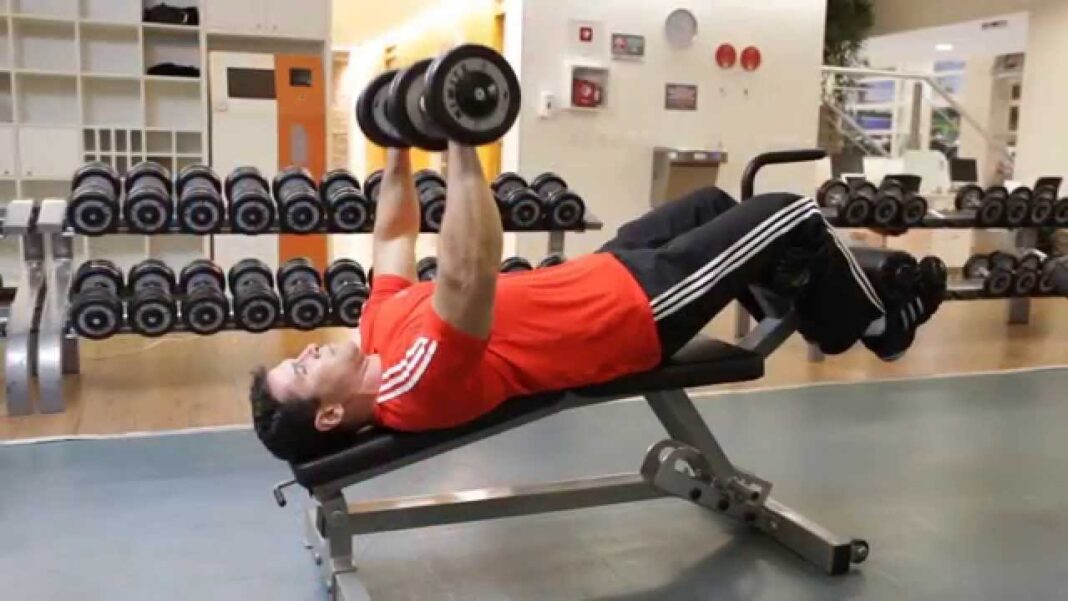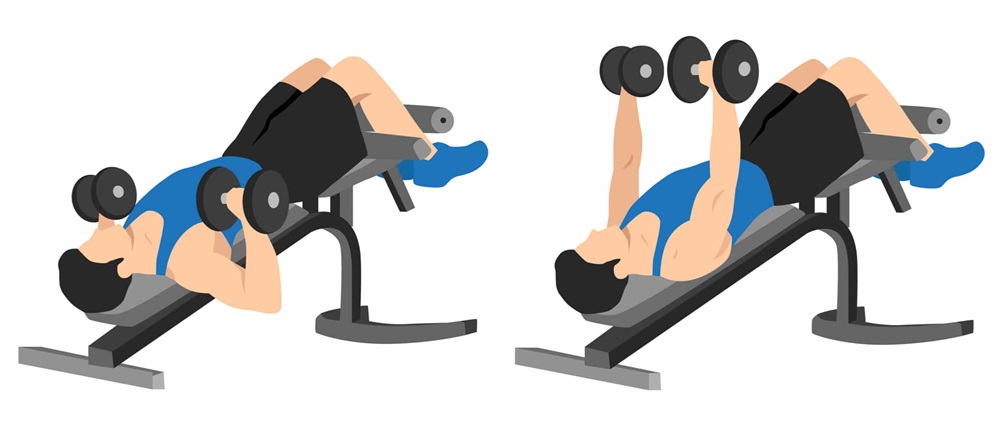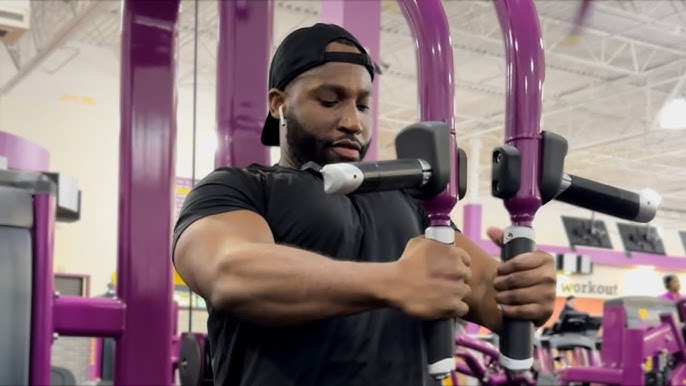Decline Dumbbell Bench Press: Lower-Chest Mass, Superior Stretch, and Balanced Strength
The Decline Dumbbell Bench Press is one of the most underrated mass-building chest exercises in bodybuilding.
While the decline barbell press is a classic for loading the lower pecs with heavy weight, the dumbbell version adds a deeper stretch, increased stability demands, and improved muscle symmetry — all critical factors in sculpting a balanced, aesthetic chest.
Dumbbells allow each pec to work independently, eliminating the asymmetry issues that many lifters unknowingly reinforce with a barbell.
They also increase the range of motion, create a longer stretch on the lower fibers of the pectoralis major, and produce a harder contraction at the top.
If your goal is complete chest development — especially the lower pecs — the decline dumbbell bench should be one of your primary hypertrophy movements.
It hits the pec fibers that give the chest depth, roundness, and a defined lower border.
Muscles Worked
Primary Muscle
- Pectoralis Major (Costal / Lower Fibers)
Secondary Muscles
- Triceps Brachii
- Anterior Deltoids (less activation than flat or incline)
- Serratus Anterior
- Stabilizers of the shoulder girdle
Why the Decline Dumbbell Bench Press Works So Well
✔ 1. Greater Range of Motion
Unlike a barbell — which stops at chest level — dumbbells allow you to lower deeper, stretching the chest fibers for more mechanical tension and hypertrophy.
The deeper the stretch, the greater the potential for growth.
✔ 2. Balanced Left–Right Workload
Each arm must work independently:
- reduces muscle imbalances
- corrects weaker-side lag
- builds symmetrical pecs
Even elite bodybuilders rely on dumbbells for symmetry refinement.
✔ 3. Reduced Shoulder Strain
The decline angle:
- naturally tucks the elbows
- minimizes shoulder rotation
- reduces deltoid involvement
- protects the rotator cuff
This makes it excellent for lifters sensitive to shoulder pain during flat bench.
✔ 4. Superior Lower-Chest Activation
This exercise directly targets the lower pecs with more isolation than the decline barbell press because the dumbbells:
- force a natural arc pattern
- allow freedom of wrist/elbow movement
- maintain tension throughout the press
The lower chest stays engaged from stretch to contraction.
✔ 5. Better Contraction at the Top
Dumbbells allow you to bring the weights together or slightly inward without touching.
This inward sweep improves:
- peak contraction
- inner-chest activation
- overall chest development
How to Set Up Properly
Bench Angle
Use a decline between 15–30°.
More than this becomes uncomfortable and reduces chest involvement.
Dumbbell Position
- Start with dumbbells on your thighs.
- Kick them up one at a time as you lie back.
- Keep your feet locked securely under the leg pads.
Starting Grip
Choose one of two positions:
Neutral-to-Semi Pronated Grip
- Palms angled at 30–45°.
- Best for shoulder comfort and chest targeting.
Pronated Grip (Standard Dumbbell Press)
- Palms facing forward.
- Great for maximizing lower-chest tension.
Both are effective, and you can rotate between grips for variation.
How to Perform the Decline Dumbbell Bench Press
- Set the Shoulder Blades
- Pull your shoulder blades down and back.
- Keep them pinned throughout the set.
- Maintain ribcage elevation for better chest engagement.
- Begin the Descent
- Lower the dumbbells slowly.
- Elbows at about 45° relative to your torso.
- Keep your forearms vertical under the dumbbells.
The dumbbells should descend toward the lower chest line.
- Feel the Stretch
Lower until your pecs feel a deep stretch:
- Dumbbells slightly outside chest level
- Upper arms drop slightly below torso
- No bouncing
- No rushing the eccentric
This is the part that builds muscle.
- Press Up With Chest Drive
- Press the weights upward in a smooth arc.
- Avoid touching the dumbbells together.
- Squeeze the chest hard at the top.
Keep the tension on the pecs — not the shoulders.
- Maintain Control
The dumbbell path should mimic a natural arc:
- down and outward on the descent
- up and inward on the press
This maximizes chest activation and reduces joint stress.
Key Form Cues (Bodybuilding-Optimized)
✔ “Elbows down at 45°, not outward like a press-up.”
✔ “Lower until your pec fibers stretch like a bowstring.”
✔ “Press up with your chest — not your shoulders.”
✔ “Bring the dumbbells inward, not together.”
✔ “Pin your shoulder blades and keep your chest high.”
✔ “Control the descent — don’t let the weights crash down.”
Programming for Hypertrophy, Strength, and Aesthetics
For Maximum Chest Size (Hypertrophy)
- 4 sets
- 8–12 reps
- 90–120 sec rest
- 2–3 sec eccentric
This is the sweet spot for lower-chest mass.
For Strength (Secondary Pressing Movement)
While dumbbells aren’t ideal for low-rep strength work, you can still build power:
- 3–4 sets
- 6–8 reps
- 2–3 minutes rest
Focus on stability and explosive concentric speed.
As an Accessory to Decline Barbell Press
Great as a follow-up lift:
- 3 sets
- 10–12 reps
- Lighter weights
- More focus on stretch and contraction
As a Chest Finisher
Perform:
- 2–3 sets
- 12–20 reps
- Slow, controlled tempo
- Maximum chest squeeze at the top
Fantastic for deep metabolic stress and pumping blood into the lower pecs.
Variations of the Decline Dumbbell Bench Press
- Neutral-Grip Decline Press
- Palms facing each other
- Easiest on shoulders
- Great triceps involvement
- Best for lifters with shoulder pain on pronated presses
- Reverse-Grip Decline Dumbbell Press
Unique feel:
- Shifts emphasis slightly higher
- Still heavily lower-pec focused
- Excellent for reducing shoulder stress
- Dead-Stop Decline Dumbbell Press
Pause at the bottom for 1–2 seconds:
- Removes momentum
- Increases time under tension
- Enhances pec activation
- Decline Dumbbell Fly-to-Press Hybrid
Perform a fly on the descent and a press on the ascent.
- Massive pec stretch
- Huge tension
- Great hypertrophy stimulus
Advanced Techniques for Maximum Lower-Chest Growth
- Mechanical Drop Set
Start with:
- 8–10 reps on standard pronated decline dumbbell press
Then immediately transition to: - neutral grip
Then to: - decline dumbbell flyes with light weight
No weight changes needed.
Burns the chest out completely.
- Rest-Pause Training
Perform:
- 8 reps
- Rest 20 sec
- 3–4 more reps
- Rest 20 sec
- Max-out mini-set
Great for increasing workload without adding sets.
- Slow Eccentrics (4–5 seconds)
Perfect for enhancing:
- stretch
- control
- hypertrophy
- mind–muscle connection
- Superset With Cable Decline Fly
This combination builds insane lower-chest detail:
- Decline Dumbbell Bench Press — 8–12 reps
- Low-to-High Cable Fly (reverse decline tension) — 12–15 reps
Common Mistakes
❌ 1. Touching Dumbbells at the Top
Removes tension from the chest.
Fix: Stop 2–3 inches short.
❌ 2. Flaring the Elbows Too Wide
Reduces chest activation, increases shoulder strain.
Fix: Maintain a 30–45° elbow angle.
❌ 3. Using Too Much Weight
Destroys form quickly.
Fix: Master control first, then increase load.
❌ 4. Letting the Dumbbells Drift Too Low
Overstretching leads to instability and potential injury.
Fix: Lower only until deep stretch is felt, not beyond.
❌ 5. Losing Shoulder Blade Retraction
This shifts load to the shoulders.
Fix: Keep scapula pinned down and back the entire set.
Mind–Muscle Connection Tips
- Think “lift with the bottom of your chest.”
- Visualize the lower pec fibers shortening and pulling the dumbbells upward.
- Keep the ribcage elevated to increase pec engagement.
- Focus on the feel — not just the reps.
- Imagine “hugging the weights inward,” not pushing them straight up.
Sample Lower-Chest Workout Featuring the Decline Dumbbell Press
Option A: Mass-Building Routine
- Decline Barbell Bench Press — 4×6–10
- Decline Dumbbell Bench Press — 4×8–12
- Chest Dips (Forward Lean) — 3×8–12
- High-to-Low Cable Fly — 3×12–15
- Push-Up (Feet Elevated) — 2×Failure
Option B: Dumbbell-Focused Chest Day
- Flat Dumbbell Press — 4×8–12
- Decline Dumbbell Bench Press — 4×10–12
- Incline Dumbbell Press — 3×8–12
- Dumbbell Flyes — 3×12–15
- Machine Chest Press — 2×15–20
Bodybuilder’s Insight
Many pro bodybuilders rely on the decline dumbbell bench to:
- add depth to the lower chest
- correct imbalances from barbell pressing
- maximize chest fullness
- build a more 3D chest profile
- reduce shoulder strain
- finish their chest after heavy compounds
Lifters who incorporate both decline barbell and decline dumbbell pressing see dramatically improved lower-pec thickness and definition.
Practical Takeaways
✔ One of the top three exercises for lower-chest hypertrophy
✔ Provides deeper stretch than the barbell version
✔ Improves symmetry and reduces imbalances
✔ Easier on the shoulders than flat pressing
✔ Should be a staple exercise in bodybuilding-focused chest programs
✔ Works great as a primary or secondary pressing movement
✔ Fantastic for variation, stretch training, and metabolic stress






